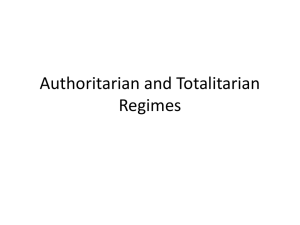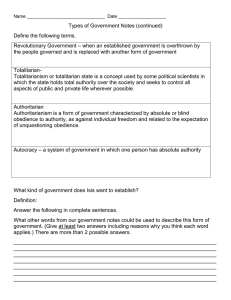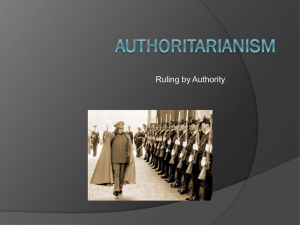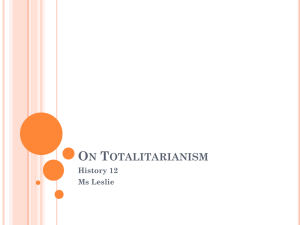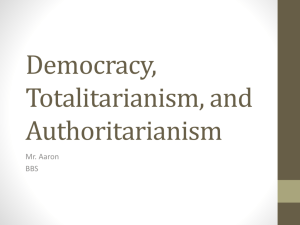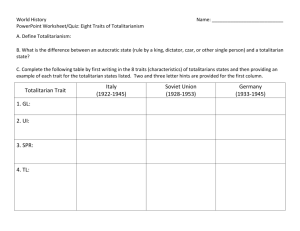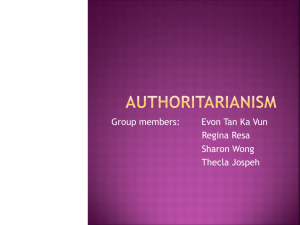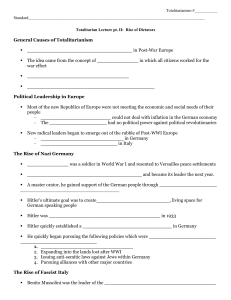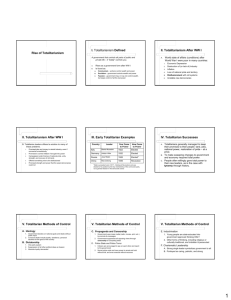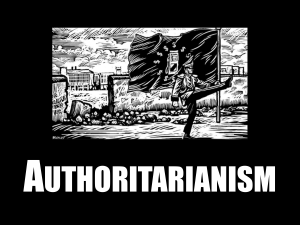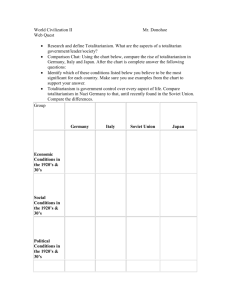Authoritarian and Totalitarian regimes Anocracy: a system where
advertisement
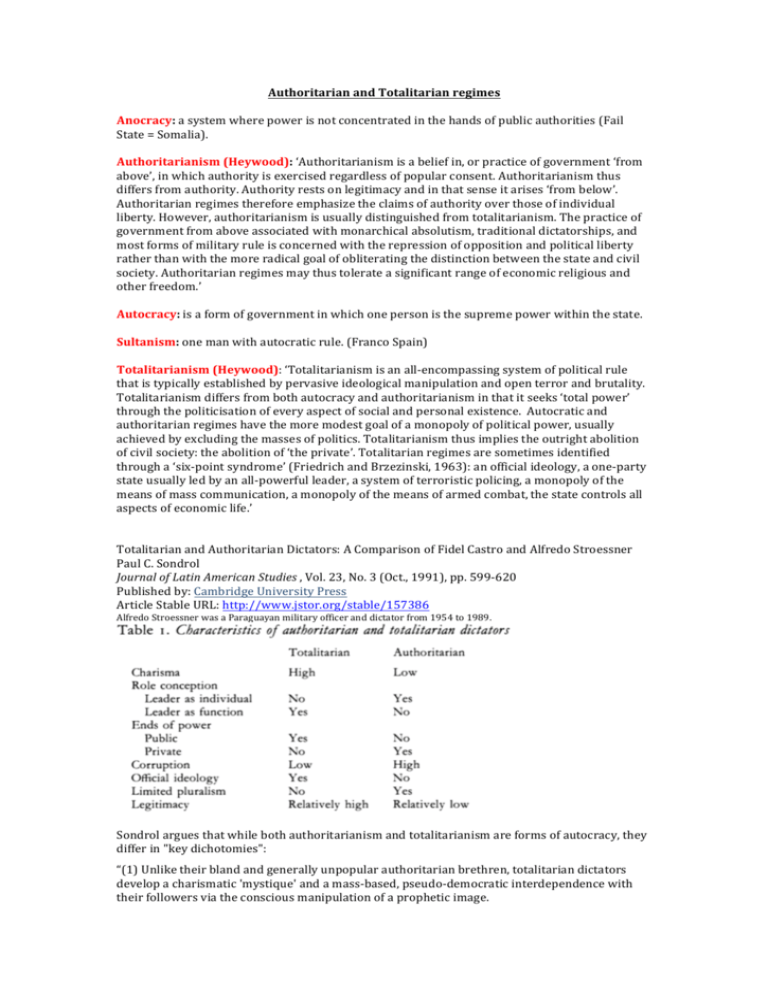
Authoritarian and Totalitarian regimes Anocracy: a system where power is not concentrated in the hands of public authorities (Fail State = Somalia). Authoritarianism (Heywood): ‘Authoritarianism is a belief in, or practice of government ‘from above’, in which authority is exercised regardless of popular consent. Authoritarianism thus differs from authority. Authority rests on legitimacy and in that sense it arises ‘from below’. Authoritarian regimes therefore emphasize the claims of authority over those of individual liberty. However, authoritarianism is usually distinguished from totalitarianism. The practice of government from above associated with monarchical absolutism, traditional dictatorships, and most forms of military rule is concerned with the repression of opposition and political liberty rather than with the more radical goal of obliterating the distinction between the state and civil society. Authoritarian regimes may thus tolerate a significant range of economic religious and other freedom.’ Autocracy: is a form of government in which one person is the supreme power within the state. Sultanism: one man with autocratic rule. (Franco Spain) Totalitarianism (Heywood): ‘Totalitarianism is an all-­‐encompassing system of political rule that is typically established by pervasive ideological manipulation and open terror and brutality. Totalitarianism differs from both autocracy and authoritarianism in that it seeks ‘total power’ through the politicisation of every aspect of social and personal existence. Autocratic and authoritarian regimes have the more modest goal of a monopoly of political power, usually achieved by excluding the masses of politics. Totalitarianism thus implies the outright abolition of civil society: the abolition of ‘the private’. Totalitarian regimes are sometimes identified through a ‘six-­‐point syndrome’ (Friedrich and Brzezinski, 1963): an official ideology, a one-­‐party state usually led by an all-­‐powerful leader, a system of terroristic policing, a monopoly of the means of mass communication, a monopoly of the means of armed combat, the state controls all aspects of economic life.’ Totalitarian and Authoritarian Dictators: A Comparison of Fidel Castro and Alfredo Stroessner Paul C. Sondrol Journal of Latin American Studies , Vol. 23, No. 3 (Oct., 1991), pp. 599-­‐620 Published by: Cambridge University Press Article Stable URL: http://www.jstor.org/stable/157386 Alfredo Stroessner was a Paraguayan military officer and dictator from 1954 to 1989. Sondrol argues that while both authoritarianism and totalitarianism are forms of autocracy, they differ in "key dichotomies": “(1) Unlike their bland and generally unpopular authoritarian brethren, totalitarian dictators develop a charismatic 'mystique' and a mass-­‐based, pseudo-­‐democratic interdependence with their followers via the conscious manipulation of a prophetic image. (2) Concomitant role conceptions differentiate totalitarians from authoritarians. Authoritarians view themselves as individual beings, largely content to control; and often maintain the status quo. Totalitarian self-­‐conceptions are largely teleological. The tyrant is less a person than an indispensable 'function' to guide and reshape the universe. (3) Consequently, the utilisation of power for personal aggrandizement is more evident among authoritarians than totalitarians. Lacking the binding appeal of ideology, authoritarians support their rule by a mixture of instilling fear and granting rewards to loyal collaborators, engendering a kleptocracy. Thus, compared to totalitarian systems, authoritarian systems may also leave a larger sphere for private life, lack a guiding ideology, tolerate some pluralism in social organization, lack the power to mobilize the whole population in pursuit of national goals, and exercise their power within relatively predictable limits.” Source: http://www.systemicpeace.org/polity/polity4.htm à XIX century: liberal revolutions + decolonisation à XX century: world wars then Cold War à 1989-­‐91: End of Cold War and Interregnum (change in social order). à 2011 Arab Spring! Today? (Freedom House) ‘North Korea is a one-­‐party, Marxist-­‐Leninist regime. Turkmenistan and Uzbekistan—are Central Asian countries ruled by dictators with roots in the Soviet period. Libya is an Arab country under the sway of a secular dictatorship, while Sudan is ruled by a leadership that has elements of both radical Islamism and a traditional military junta. The remaining worst-­‐ rated states are Burma, a tightly controlled military dictatorship;Equatorial Guinea, a highly corrupt regime with one of the worst human rights records in Africa; Eritrea, an increasingly repressive police state; and Somalia, a failed state. The one worst-­‐rated territory in the survey, Tibet, is under Chinese jurisdiction. An additional 10 countries and territories received scores that were slightly above those of the worst-­‐ranked countries, with ratings of 6,7 or 7,6 for political rights and civil liberties: Belarus, Chad, China, Côte d’Ivoire, Cuba, Laos, Saudi Arabia, South Ossetia, Syria, and Western Sahara.’
